
Gluta travancorica is a species of plant in the family Anacardiaceae. It is endemic to the southern Western Ghats in India.
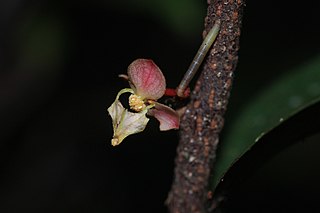
Orophea thomsonii or Thomson's Turret Flower is a species of shrub or small tree in the Annonaceae family. It is native to Kerala and Tamil Nadu in India and endemic to the Western Ghats mountain range.

Palaquium ravii is a species of tree in the family Sapotaceae. It is endemic to the Western Ghats mountains and native to Kerala and Tamil Nadu in India.

Phyllanthus anamalayanus is a species of plant in the family Phyllanthaceae. It is endemic to the Anamalai Hills in Coimbatore district in the state of Tamil Nadu, India. The species is a shrub or small tree occurring in the understorey of mid-elevation tropical wet evergreen forests in the Anamalai Hills, and is endemic to the Western Ghats. It is threatened by habitat loss.

Syzygium densiflorum is a species of evergreen tree in the family Myrtaceae. It is endemic to the Western Ghats mountains, India. The species is categorised as Vulnerable in the IUCN Red List.

Vateria indica, the white dammar, is a species of tree in the family Dipterocarpaceae. It is endemic to the Western Ghats mountains in India. It is threatened by habitat loss. It is a large canopy or emergent tree frequent in tropical wet evergreen forests of the low and mid-elevations.
Diospyros atrata is a tree in the Ebony family. It commonly grows to 25 metres tall. The plant can be seen in subcanopy trees in medium elevation wet evergreen forests between 1000 and 1400 m in Western Ghats- South Sahyadri, Kerala, and Tamil Nadu in India and from Kandy district in Sri Lanka

Diospyros candolleana, is a tree in the Ebony family, endemic to the Western Ghats of India and Sri Lanka. The trees are usually 20m tall, and found as subcanopy trees in wet evergreen forests up to 90m.

Garcinia pushpangadaniana is a tree species in the family Clusiaceae. It was described in 2013 from a population found in the southern part of the Western Ghats in India. The specific epithet of this species honors Dr. P. Pushpangadan, former Director of Jawaharlal Nehru Tropical Botanical Garden & Research Institute.
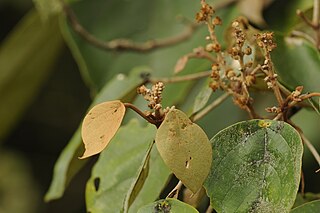
Mallotus tetracoccus, also known as the rusty kamala, is a species of flowering plant in the family Euphorbiaceae. It is a tree species found in parts of south Asia, typically occurring in the edges of tropical wet evergreen and semi-evergreen forests.
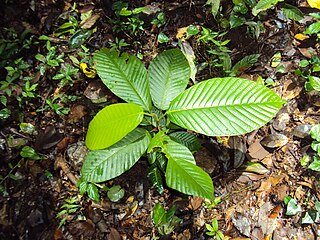
Dipterocarpus bourdillonii is a species of large tree in the family Dipterocarpaceae endemic to the Western Ghats principally in the state of Kerala in India. It is a Critically Endangered species according to the IUCN Red List of Threatened Species. It is a characteristic tree of the low-elevation tropical wet evergreen rainforests in the Western Ghats.

Cullenia exarillata is a flowering plant evergreen tree species in the family Malvaceae endemic to the rainforests of the southern Western Ghats in India. It is one of the characteristic trees of the mid-elevation tropical wet evergreen rainforests and an important food plant for the endemic primate, the lion-tailed macaque.

Bhesa indica is a flowering plant tree species in the Centroplacaceae family. It is distributed along the tropical wet evergreen forests of the Western Ghats of India. It is considered synonymous with Bhesa paniculata by some authors.

Actinodaphne bourdillonii is a species of the genus Actinodaphne of the flowering plant family Lauraceae, commonly called the malavirinji, eeyoli, and pisa. It is endemic to the Southern Western Ghats. Its general habitat is shola and montane evergreen forests from 600 to 2,000 metres elevation.

Dipterocarpus indicus is a species of large tree in the family Dipterocarpaceae endemic to the Western Ghats of India. It is recognised as an endangered species under the IUCN Red List of Threatened Species 2021.

Myristica beddomei is a species of tree in the family Myristicaceae. It is endemic to the Western Ghats, India, where it is frequent in the mid-elevation wet evergreen forests and an important food tree of hornbills. The species has been earlier misidentified in regional floras and herbarium specimens as Myristica dactyloides Gaertn., the latter occurring only in Sri Lanka.

Diospyros paniculata, or the panicle-flowered ebony, is a species of tree in the ebony family. Endemic to the Western Ghats area of India and parts of Bangladesh, the species is currently listed as Vulnerable in the IUCN Red List.
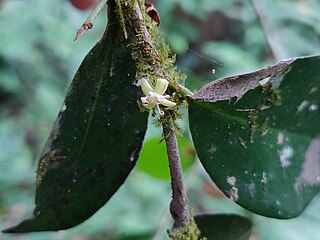
Drypetes wightii is an evergreen tree species endemic to the Western Ghats, India. The species is considered Vulnerable under the IUCN Redlist of Threatened Species.
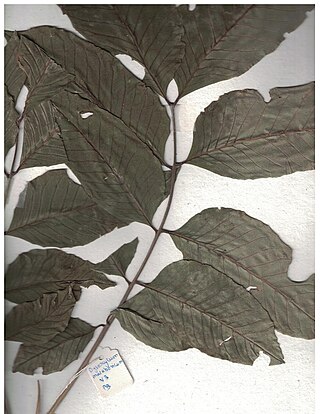
Dysoxylum malabaricum, or white cedar, is a tree species endemic to the Western Ghats, India. The species is considered Endangered under the IUCN Red List of Threatened Species.
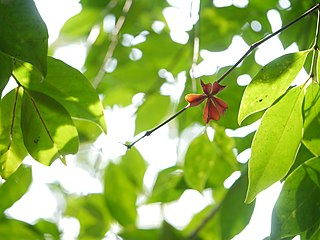
Euonymus indicus, the Indian spindle tree, is a small evergreen understorey tree endemic to the Western Ghats of the Indian peninsula and belongs to the family Celestraceae. It can grow up to a height of 13 m and girth up to 1 m.




























